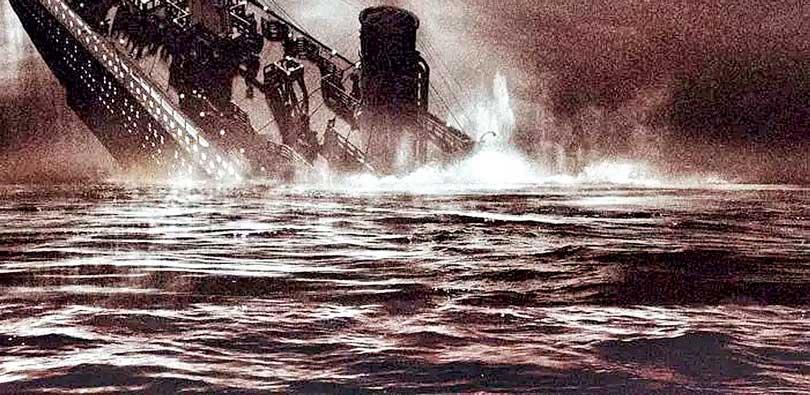16 Apr 2024 - {{hitsCtrl.values.hits}}

The collapse of the Meethotamulla dump (below) marked one of the most serious and tragic man-made environmental disasters in recent Sri Lankan history

Numerous volumes have been published exploring the factual, fictional, mythical and mysterious aspects of the tragic Titanic disaster
 After an airstrike by Israel claimed the lives of two Iranian generals in Syria last week, Iran retaliated with firing 200 missiles. This escalation of tensions raises the risk of the Gaza conflict expanding into a regional conflagration and potentially igniting a Third World War (WWIII). The first wave of missiles struck Israel around two in the morning on April 13, local time, approximately 11 hours before the onset of Nonagathe. Iran and Israel Have a Long History of Clandestine Attacks. The regional rivals have for decades targeted each other’s interests, including with a recent strike in Syria that killed three
After an airstrike by Israel claimed the lives of two Iranian generals in Syria last week, Iran retaliated with firing 200 missiles. This escalation of tensions raises the risk of the Gaza conflict expanding into a regional conflagration and potentially igniting a Third World War (WWIII). The first wave of missiles struck Israel around two in the morning on April 13, local time, approximately 11 hours before the onset of Nonagathe. Iran and Israel Have a Long History of Clandestine Attacks. The regional rivals have for decades targeted each other’s interests, including with a recent strike in Syria that killed three
Iranian commanders
The period known as the
Nonagathe, or the ‘malefic period,’ occurs between the end of the
Old Year and the beginning of the New Year. According to mythological beliefs, this period is considered inauspicious, and astrology advises avoiding initiating important activities and pursuing material goals; instead it is advised for people to be focused on observing religious rituals. This prompts reflection, introspection and spiritual practices rather than engaging in worldly pursuits.
In 2017, what was meant to be a joyous celebration of the National New Year, turned into a nightmare for many families living near the Meethotamulla garbage dump. Mounds of garbage crashed down on their houses in a devastating landslide.
Meethotamulla garbage collapse
The collapse of the Meethotamulla garbage mound occurred between 2:30 pm and 3:00 pm onApril 14, well past the Nonagathe. The immense force of the garbage landslide, reportedly triggered by a fire, resulted in widespread destruction. Sturdy houses several storeys high, were swept away and destroyed, along with large trees being uprooted in its wake.
Nagahamulla, Neelagewatta, Daham Mawatha and 23 Watta were the affected areas. Throughout the night, rescuers worked tirelessly and successfully rescued 11 people alive from under the rubble; swiftly transporting them to the National Hospital. A victim shared, “We felt helpless as many people were trapped and crying out for help. Some of the bodies were in pieces.” Many residents claimed that their pets, particularly dogs, sensed the impending disaster almost an hour before the landslide struck. Witnesses observed that dogs, whether locked inside houses or chained at various locations, became agitated and attempted to escape.
The collapse of the Meethotamulla dump marked one of the most serious and tragic man-made environmental disasters in recent Sri Lankan history. The catastrophe resulted in the loss of 32 lives, the complete destruction of
60 houses, and partial damage to 77 others resulting in the displacement of 625 individuals from 180 families.
According to expert analysis, the infiltration of rainwater through the garbage dump caused instability in the bottom layers, raised the water table, and weakened the upper layers due to water accumulation.
112th Anniversary of the sinking of the Titanic
The Titanic, considered the most elegant luxury liner and the largest moving object ever built at the time, struck an iceberg on its maiden voyage during the night of
April 14, 1912, and subsequently sank in the Atlantic waters, resulting in the loss of over 1500 passengers and crew members. Numerous volumes have been published exploring the factual, fictional, mythical, and mysterious aspects of this tragic disaster.
Despite the Titanic’s significance in naval architecture and technological achievement, astrological prophecy has received little emphasis in its narrative, with few exceptions such as Eileen Grimes’ bestseller,
“Titanic Astrology: The Grand Design of a Famous Shipwreck.” The Titanic, under the command of Capt. Edward John Smith, embarked on its maiden voyage from Southampton, England, on April 10, making a stopover in France before commencing its journey from Queenstown, Ireland, on April 11, bound for New York.
On April 13, while the Titanic was at sea, Sri Lankans and people from several other nations in the region observed the dawn of a ‘new year,’ coinciding with the astrological transition of the Sun from Pisces to Aries in the celestial sphere. During this time, an astrologically defined ‘malefic’ or non-auspicious
Nonagathe of 12 hours and forty-eight minutes is observed, during which significant activities, including interactions with bodies of water like tanks, rivers, and streams, are avoided. This tradition also extends to refraining from drawing water from wells, a practice upheld for centuries.
It would indeed be intriguing to explore the influence of the ‘Malefic Period’ on the tragedy of the
Titanic. Accurate times of the incidents and the precise position of the ship are essential in examining the effects of this phenomenon. The recorded times of impact (11:40 p.m. on April 14) and sinking (2:20 a.m. on April 15) and the coordinates (41° 432’ 553 N, -- 49° 562’ 453 W), taken from the ship owners’ account, are considered reliable for this analysis.
Before the introduction of
‘Nautical Standard Time’ in 1920 for ships operating in high seas, the time used by sailing ships was subject to various criteria. However, when calculating the local time of the disaster, we find a time difference of 8 hours and 49 minutes. This implies that the Titanic struck the iceberg at 8:29 a.m. on April 15 local time, and after two hours and forty minutes, at 11:09 a.m. local time, exactly 112 years ago, the Titanic sank. Exploring these details further one could shed light on the potential influence of astrological phenomena on this historic tragedy.
The timeline of the Titanic’s voyage, as submitted to the Committee of Inquiry, indicates that the ship left Southampton harbor, England, at noon on April 10 (5:30 p.m. local time, long before the malefic period began). It then proceeded to France and departed from Cherbourg port at 8:10 p.m. (1:40 a.m. on April 11 local time). Afterward, the Titanic reached Queenstown, Ireland (now Cobh), at 11:30 a.m. The starboard anchor was raised for the last time, and the Titanic departed on her first trans-Atlantic crossing for New York, slipping away from the berth carrying approximately 2227 passengers at 1:30 p.m. on April 11, 1912. The local time at this point was 7:00 p.m. on April 11, which was long before the malefic period.
The information from the almanac, as published in “The Dinamina” news sheet of April 3, 1912, indicates that the malefic period began at 2:53 p.m. on April 12 and lasted until 3:41 a.m. (local times) on April 13. This suggests that the disaster did not occur during the malefic period. However, the next question arises: Did the ship sail from Southampton or
Queenstown heading for New York during the said period?
Those steadfast believers in the influence of “bad and good times” or Nekath may argue that the Titanic sailed across the Atlantic during the malefic period, attributing the disaster to this astrological phenomenon. On the other hand, skeptics may argue that the ship set sail long before the malefic period began, emphasizing other factors as contributing to the tragedy. In our last week’s column, we emphasized that the adherence to auspicious times during Avurudu is more rooted in cultural traditions than religious doctrine. Despite its cultural significance, astrology lacks empirical evidence and scientific validity, rendering it a pseudoscience lacking rigorous logical analysis.
(The writer can be reached on [email protected])
24 Nov 2024 3 hours ago
24 Nov 2024 3 hours ago
23 Nov 2024 23 Nov 2024
23 Nov 2024 23 Nov 2024
23 Nov 2024 23 Nov 2024